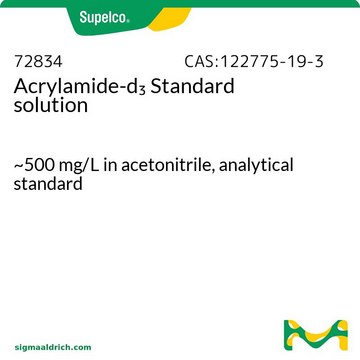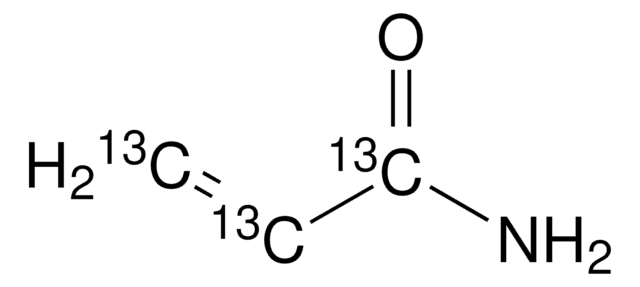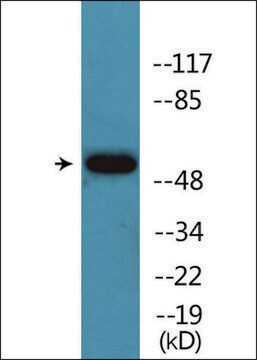01700
Acrylamid
purum, ≥98.0% (GC)
Synonym(e):
2-Propenamid, Acrylsäureamid
About This Item
Empfohlene Produkte
Dampfdichte
2.45 (vs air)
Qualitätsniveau
Dampfdruck
0.03 mmHg ( 40 °C)
Qualität
purum
Assay
≥98.0% (GC)
bp
125 °C/25 mmHg (lit.)
mp (Schmelzpunkt)
81-87 °C
82-86 °C (lit.)
Löslichkeit
water: soluble 200 g/L at 20 °C
Lagertemp.
room temp
SMILES String
NC(=O)C=C
InChI
1S/C3H5NO/c1-2-3(4)5/h2H,1H2,(H2,4,5)
InChIKey
HRPVXLWXLXDGHG-UHFFFAOYSA-N
Suchen Sie nach ähnlichen Produkten? Aufrufen Leitfaden zum Produktvergleich
Anwendung
Biochem./physiol. Wirkung
Signalwort
Danger
Gefahreneinstufungen
Acute Tox. 3 Oral - Acute Tox. 4 Dermal - Acute Tox. 4 Inhalation - Carc. 1B - Eye Irrit. 2 - Muta. 1B - Repr. 2 - Skin Irrit. 2 - Skin Sens. 1 - STOT RE 1 Oral
Zielorgane
Peripheral nervous system
Lagerklassenschlüssel
6.1C - Combustible acute toxic Cat.3 / toxic compounds or compounds which causing chronic effects
WGK
WGK 3
Flammpunkt (°F)
280.4 °F - closed cup
Flammpunkt (°C)
138 °C - closed cup
Persönliche Schutzausrüstung
Eyeshields, Faceshields, Gloves, type P3 (EN 143) respirator cartridges
Hier finden Sie alle aktuellen Versionen:
Besitzen Sie dieses Produkt bereits?
In der Dokumentenbibliothek finden Sie die Dokumentation zu den Produkten, die Sie kürzlich erworben haben.
Kunden haben sich ebenfalls angesehen
Unser Team von Wissenschaftlern verfügt über Erfahrung in allen Forschungsbereichen einschließlich Life Science, Materialwissenschaften, chemischer Synthese, Chromatographie, Analytik und vielen mehr..
Setzen Sie sich mit dem technischen Dienst in Verbindung.






